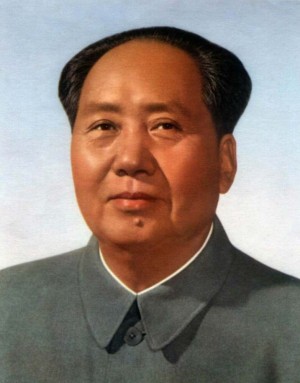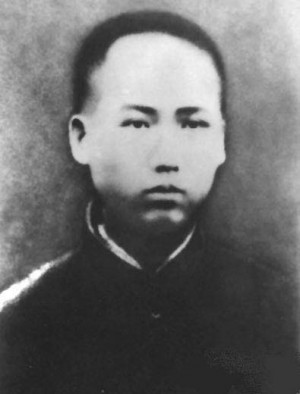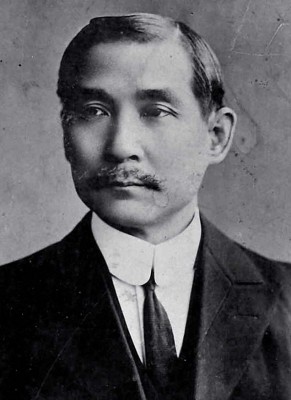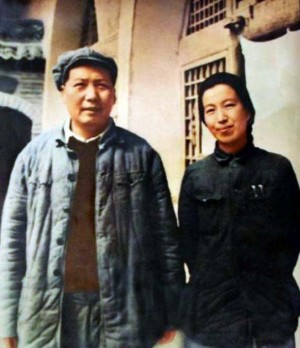| Mao Zedong | |
|---|---|
 |
|
| Chinese Communist Leader | |
| In Power | 1945-1976 |
| Born | Dec. 26, 1893 Shaoshan |
| Died | Sept. 9, 1976 Beijing |
| Nationality | Chinese |
| Political Party | Communist Party of China |
Mao Zedong (1893-1976) was the former communist leader of China and is commonly referred to as Chairman Mao, due to his long-standing role with the Communist Party of China. His name has also been frequently translated into English as Mao Tse-tung, but this is less common now.
He was the founder of the People’s Republic of China, which he set up in 1949 and governed until his death in 1976. Under his rule, he converted China into a Communist state. Mao was greatly influenced by the teachings of Lenin and Marx, but he developed his own modifications to their communist ideas that are known as Maoism.
Early Life
Mao was born in 1893 in Hunan Province. His family was quite affluent, his father having made substantial profits from trading in grain and money lending. While his father was essentially agnostic, Mao’s mother was a practicing Buddhist, and she taught her children, including Mao, to worship Buddha. Mao was initially open to Buddhist teachings, but he lost interest in the religion while still a teenager.
Mao’s father recognized the benefits of his own limited education, and considered a proper education for his children as being very important. Mao was sent to school, where he studied classic Chinese texts and learned about Confucius. However, the young boy was bored reading the ancient material, and decided to run away from home when he was just 11. However, before he got far, his father found him and brought him back home.
Upon finishing school when he was 13, Mao was forced to take part in an arranged marriage with a girl who was 4 years older than him. Despite his young age and his father’s reputation for physical punishment, Mao steadfastly refused to recognize the marriage, or to live with his wife. Instead, he moved away to live with a friend. After a time, he returned to work on his father’s farm, and the strife over his marriage ended when his bride died at the age of 21.
Political Formation
 Mao became interested in politics and biographical works while still working as a farmer. He was a voracious reader with a wide taste in historical and political themed books. It is known that he was greatly impressed by people as diverse as George Washington and Napoleon.
Mao became interested in politics and biographical works while still working as a farmer. He was a voracious reader with a wide taste in historical and political themed books. It is known that he was greatly impressed by people as diverse as George Washington and Napoleon.
He and his family were plunged into a political and economical dilemma when peasants attacked the farm during a famine and stole the grain. This action followed earlier attacks in the capital of Hunan province. These had been resisted violently by the authorities, who put the leaders to death, something of which Mao disapproved.
Mao moved to the Hunan capital, Changsha, to continue his education. While there he was exposed to the revolutionary writings of Sun Yat-sen, who wanted to overthrow the Chinese monarchy and establish the country as a republic. Mao published his first ever political treatise on a school notice board. In this he expressed agreement with some of Sun’s proposals, but his overall view of a possible revolution was more moderate.
Around the same time, Mao had his pigtail removed in protest as pigtails represented subservience and obedience to the emperor. He also began to study socialist pamphlets.
Martial Law
Mounting criticism of the emperor in Changsha, driven by Sun’s ideology, led the governor of the city to attempt to impose martial law. The local military refused to implement martial law, and instead declared their allegiance to the rebels. The emperor’s governor left the city, and it was left under the control of the rebels. Mao joined the rebel forces but did not take part in any military action. He returned to civilian life just 6 months later.
Over the coming years, Mao embarked on several different career paths, but quickly gave each one up. He also quit the school in Changsha, instead undergoing extensive self-education courtesy of the public library. His father was unhappy with his son’s waywardness and stopped supporting him financially. He enrolled in a new school, where he completed his studies. He was very active in student politics and was appointed leader of the student revolutionary army.
Peking and Shanghai
 In 1917, Mao moved to Peking, where he got a job at the university’s library, thanks to his association with Yang Changji. Mao was appointed assistant to Li Dazhao, who had communist leanings. Li wrote extensively about the Bolshevik revolution that was taking place in Russia. During this period, Mao became more and more Marxist in his views.
In 1917, Mao moved to Peking, where he got a job at the university’s library, thanks to his association with Yang Changji. Mao was appointed assistant to Li Dazhao, who had communist leanings. Li wrote extensively about the Bolshevik revolution that was taking place in Russia. During this period, Mao became more and more Marxist in his views.
Japan
There was widespread discontent throughout China because of territory ceded to the Japanese as part of the Treaty of Versailles. Mao founded a radical magazine in July 1919, aimed at ordinary peasants, to advance his revolutionary sentiments. He was active in organizing protests in Changsha, to which he had returned. When his magazine was shut down by the authorities, he established another publication, followed by a third when that too was shut down.
During this period, Mao began to formulate some of his feminist ideas as he wanted women to have more freedom in Chinese society, and arranged marriages to be forbidden. He went to Peking once again, where his reputation was steadily growing. He then moved to Shanghai, where he took a job in a laundry and became acquainted with leading personalities in the Chinese Nationalist Party (Kuomintang, or KMT), including General Tan Yankai.
Mao began organizing support for Tan, who was planning to overthrow the warlord Zhang Jinghui. Tan led his forces into Changsha, forcing Zhang to abandon the city. Mao had galvanized student support behind Tan in this action.
Communist Party
In 1921, the Communist Party of China (CPC) was formally established in Shanghai by Li Dazhao, Mao’s former boss in the Peking University library. Mao established a branch of the party in Changsha. Other branches were founded in other cities, including Peking, and the first National Congress was held in July, attended by just 13 delegates, including Mao.
Mao was put in charge of the Changsha branch, and began actively recruiting members for the party. He established a Self Study University, which was essentially a library service that made revolutionary and Marxist literature available to those who attended. He was also active in trying to organize strikes throughout Hunan province, with some success, especially with miners.
Kuomintang and the Communist Party of China
At the third National Congress, held in 1923, Mao was elected as a committee member of the party, and he moved once again to Shanghai to fulfill this role. Shortly after, he was also elected as a committee member of the KMT Central Executive. His influence in the KMT continued to increase, and he was made director of Propaganda, which gave him control of the KMT weekly newsletter. He was
put in charge of the Peasant Movement Training Institute, a quasi military body set up to train peasants in fighting and military skills. In late 1925, Mao was forced to move to Canton as his activities came under scrutiny by the authorities.
The Kuomintang Split
Not all the KMT leaders were fully behind open rebellion. The party became increasingly divided between left and right wing factions. The divisions became more pronounced as peasant revolts resulted in some wealthy landowners being displaced. Many of the KMT leadership were also landowners, and were disturbed by these developments. This eventually led to a split between Chiang Kai-Shek and the communist factions within KMT. Several bloody encounters ensued in the struggle to gain overall control, leading eventually to the expulsion of communist supporters from KMT.
The Red Army
Changsha had been taken by Chiang, and Mao now found himself leading a peasant army, known as the Red Army, to retake the city. The plan failed, and Mao was forced to flee south. Over the following years, the ongoing battles between KMT and the CPC saw Mao being forced to retreat on numerous occasions. He began to use guerilla tactics against the KMT.
The Long March
CPC soldiers in the Red Army had been surrounded by KMT forces, but managed to break out in 1934. Not having any permanent base, the Red Army spent most of the next year on the move. By the time they reached Shenshi, the force had been depleted by illness, defeats in numerous battles, starvation and desertions.
Moving to Yan’an, Mao began to form alliances with local chiefs, and began to build up his army once more, and set about recapturing Chinese territory from the Japanese. In an incredible turn, Mao persuaded the KMT to reform their alliance to fight their common enemy, the Japanese.
The fight against the Japanese was very popular, and Mao’s army quickly swelled to over half a million, and recorded several victories over the Japanese. However, hostilities between the CPC and KMT then resumed and a state of civil war again took place. Mao had renamed his Red Army to the People’s Revolutionary Army (PRA). In January 1949, the PRA won a decisive victory over Chiang, forcing him to flee to Taiwan.
Leadership
This paved the way for Mao to become a leader of China, and he established the People’s Republic of China in 1949. He was then chairman of the CPC, and was commonly referred to as Chairman Mao.
Mao began a brutal and extensive campaign of land reform, with hundreds of thousands of landowners being killed by Mao’s supporters. He initiated a campaign to wipe out opponents that he called counter-revolutionaries. Estimates of the deaths, which included public executions, vary from 2 million to 6 million.
In the early 1950s he turned his attention to attacks on other forms of capitalism, targeting industrialists and government officials amongst others. He adopted tactics similar to those of Stalin, turning family members against each other, and encouraging people to betray their neighbors. One of his most brutal tactics was to force people to commit suicide, rather than have his men kill them.
The 5-Year Plans
In 1953, he launched his first 5-year plan, whose primary aim was to turn China into a dominant world power by concentrating on industrial development. The measure was successful to a large degree, and China became quite wealthy. He launched a second 5-year plan, called the Great Leap Forward, which introduced widespread collective measures, and price control. Although initially tolerant of critics, Mao soon introduced persecution of those who opposed his ideas.
The atmosphere of terror that had been created meant many local leaders exaggerated production figures. As a result, the authorities were taking so much food produce that a great famine was triggered, resulting in the deaths of around 30 million people.
The Cultural Revolution
 The Cultural Revolution was launched in 1966, in what many commentators see as an attempt by Mao to damage those who had disagreed with his policies during the Great Leap Forward. Mao had become concerned that the net result of his policies was to simply replace the old elite with an equally corrupt new one. He established the Red Guards, who were to challenge authority at every level. Chinese schools were shut down, and many people deemed as intellectuals were sent to work on farms in an attempt to reeducate them.
The Cultural Revolution was launched in 1966, in what many commentators see as an attempt by Mao to damage those who had disagreed with his policies during the Great Leap Forward. Mao had become concerned that the net result of his policies was to simply replace the old elite with an equally corrupt new one. He established the Red Guards, who were to challenge authority at every level. Chinese schools were shut down, and many people deemed as intellectuals were sent to work on farms in an attempt to reeducate them.
The revolution effectively offset all the economic advances that had been made during the first 5-year plan, and the country descended into economic chaos. Despite the widespread poverty and famine, China expended vast amounts of money in developing military equipment, including nuclear weapons.
The Death of Mao
Mao died on September 9, 1976. His health had been declining for several years. He had suffered several heart attacks, and had suffered a severe lung infection in the days prior to his death. Although he had specifically instructed that he be cremated, his body was interred in a mausoleum.